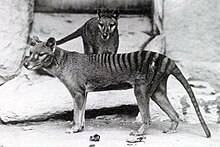| Thylacinus Temporal range:
| |
|---|---|

| |
| Thylacine (Thylacinus cynocephalus) | |
| Scientific classification | |
| Domain: | Eukaryota |
| Kingdom: | Animalia |
| Phylum: | Chordata |
| Class: | Mammalia |
| Infraclass: | Marsupialia |
| Order: | Dasyuromorphia |
| Family: | †Thylacinidae |
| Genus: | †Thylacinus Temminck, 1824 |
| Species | |
Thylacinus is a genus of extinct carnivorous marsupials in the family Thylacinidae. The only recent member was the thylacine (Thylacinus cynocephalus), commonly also known as the Tasmanian tiger or Tasmanian wolf. The last known Tasmanian tiger was in the Beaumaris Zoo in Tasmania, eventually dying in 1936. The earliest known member of the genus, Thylacinus macknessi appeared during the Early Miocene, around 16 million years ago, and was smaller than the modern thylacine, with a body mass of about 6.7–9.0 kilograms (14.8–19.8 lb). Thylacinus represented the only extant genus of the family after the beginning of the Pliocene around 5 million years ago. Over time members of the genus saw an increase in body mass and a greater adaption to hypercarnivory in their dental morphology.[2]
A tooth referable to Thylacinus was collected from the Late Oligocene Wayne's Wok site at the Riversleigh World Heritage Area, making it the oldest record of the genus.[3]
- ^ Churchill, T. J.; Archer, M.; Hand, S. J. (2024). "Three new thylacinids (Marsupialia, Thylacinidae) from late Oligocene deposits of the Riversleigh World Heritage Area, northwestern Queensland". Journal of Vertebrate Paleontology. doi:10.1080/02724634.2024.2384595.
- ^ Rovinsky, Douglass S.; Evans, Alistair R.; Adams, Justin W. (2 September 2019). "The pre-Pleistocene fossil thylacinids (Dasyuromorphia: Thylacinidae) and the evolutionary context of the modern thylacine". PeerJ. 7: e7457. doi:10.7717/peerj.7457. ISSN 2167-8359. PMC 6727838. PMID 31534836.
- ^ B. Wroe S. 2003. "Australian marsupial carnivores: recent advances in palaeontology." In: Jones M, Dickman C, Archer M, eds. Predators with Pouches: The Biology of Carnivorous marsupials. Collingwood: CSIRO Publishing. 102-123